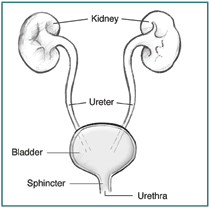Urine is normally sterile (it does not contain bacteria). A urine infection is caused by bacteria that get into the urine. Most are due to the bacteria that are commonly found in the bowel. They cause no harm in the bowel, but can cause infection in other parts of the body. These bacteria can lie near the anus (back passage) and travel up the urethra into the bladder. Here bacteria can multiply quickly, causing infection. Infection just affecting the bladder is called cystitis or a lower urinary tract infection (UTI), infection affecting the kidneys is called pyelonephritis or an upper UTI. Nearly 1 in 20 boys and more than 1 in 10 girls have at least one urine infection by the time they are 16 years old.
Patient information: Urinary Tract Infection (UTI) Prevention in Children (Paediatric Guidelines)

Understanding the urinary tract
We have two kidneys, one on each side of the abdomen. They filter our blood and make urine. The urine passes down tube like structures called ureters into the bladder where it is stored. Urine is passed out through the urethra. A muscle, also called a sphincter controls the release of urine from the bladder by contracting or relaxing. Children who are not yet continent are not yet able to control this.

Young children and Babies | Older Children |
Fever | Abdominal pain |
Irritable – just not right | Pain passing urine |
Vomiting and/ or diarrhoea | Going to toilet more often |
Drowsy | Bedwetting where they were previously dry |
Crying, off feeds, generally unwell |
- As most UTI’s are caused by bacteria from the digestive tract how a child wipes after going to the bathroom can make a significant difference.
- In some children, how the urinary tract is placed, makes them likely to get a UTI.
- UTI’s are more common in girls due to the proximity of the urethra to the anus.
- Children can learn “bad habits” such as holding their pee for too long or rushing out of the bathroom too quickly. If urine remains in the bladder for too long this can allow bacteria to grow.
A sample of urine should be sent to the lab to see if bacteria are present. The urine sample should not come in contact with skin or other things that might contaminate it. In older children, a mid stream urine collection is recommended. For babies/ children in nappies, urine must be “caught” as they pass it; a good time is just after a feed ( take the nappy off).
Use the toilet more often – Young children will often hold their pee in for long periods of time to avoid taking breaks from play. Some children who have experienced UTIs might also avoid peeing due to the pain they experienced before. Ideally children should pee every 2 -3 hours, this could be incorporated into a daily routine.
Empty the bladder completely – Some children will not empty their bladder completely as they may be anxious to get back to their activity. They can become so used to doing this the bladder tightens in the middle of peeing so they stop too early. Ask your child to double pee – trying to pee again immediately after peeing and will promote better emptying.
Proper Wiping- Girls should be encouraged to wipe from front to back – this helps minimise the chance of bacteria entering the urethra. Also make sure they know not to use the toilet tissue that was used to wipe their bottom to wipe their urethra
Clothing Choices – loose fitting cotton underpants are recommended as it allows better air circulation. If your child cannot control when they go to the bathroom they should be changed frequently, as moisture can allow bacteria to grow causing infection
Avoid bubble baths - all children should avoid bubble baths with frothy soap as it can cause skin irritation around the genitalia. Showers or regular baths are fine.
Stay Hydrated – your child’s pee should be a light colour, almost like water. The more they drink, the more they will pee. Keeping the bladder flushed frequently will keep it healthy. If the urine is dark in colour it is more likely to sting and make them want to hold their pee in.
Avoid constipation – Children should ideally have one bowel movement a day. Children that hold stool in are more likely to hold urine in. When there is stool in the lower part of the bowel, it is in closer proximity to the urethra. Staying hydrated can help prevent constipation, however some children may need further help.
Cranberry Juice – Some feel that drinking cranberry juice or taking cranberry supplements will help to prevent UTI’s. Evidence of benefit in children is unclear and recent trials have shown no benefit but also no harm.
Probiotics– These are not recommended as they have not been shown to have any benefit in preventing UTI’s in children.
Erika N., Samuel N., Regula L.-E. Methods to prevent recurrent cystitis: Where's the evidence?. Swiss Med. Wkly. 2017;147(Supplement 222):9S. Cited in: Embase at http://ovidsp.ovid.com/ovidweb.cgi?T=JS&PAGE=reference&D=emed18&NEWS=N&AN=627024049. Accessed June 19, 2020.
Schwenger EM, Tejani AM, Loewen PS. Probiotics for preventing urinary tract infections in adults and children. Cochrane Database Syst Rev. 2015;(12):CD008772. doi:10.1002/14651858.CD008772.pub2, 10.1002/14651858.CD008772.pub2
Tewary K, Narchi H. Recurrent urinary tract infections in children: Preventive interventions other than prophylactic antibiotics. World j. methodol.. 2015;5(2):13-9. doi:10.5662/wjm.v5.i2.13, 10.5662/wjm.v5.i2.13
Williams G, Craig JC. Prevention of recurrent urinary tract infection in children. CurrOpin Infect Dis. 2009;22(1):72-6. doi:10.1097/QCO.0b013e328320a885, 10.1097/QCO.0b013e328320a885
Persad S., Watermeyer S., Griffiths A., Cherian B., Evans J. Association between urinary tract infection and postmicturition wiping habit. Acta ObstetGynecol Scand. 2006;85(11):1395-1396. Cited in: Embase at http://ovidsp.ovid.com/ovidweb.cgi?T=JS&PAGE=reference&D=emed9&NEWS=N&AN=44985649. Accessed June 19, 2020.
Specialty Doctor in Paediatrics with Renal Interest: Dr Janaki Vedarajan- Contact via secretary or email- janaki.vedarajan@nhs.scot
Paediatric Renal Secretary: Paula Graham, Raigmore Hospital- 01463 701342 (from outside the hospital). Extension 7542 (from within the hospital). Mon-Fri 9-5pm
| Abbreviation | Meaning |
| BP | Blood Pressure |
| DMSA | dimercapto succinic acid (radioisotope study) |
| eGFR | estimated Glomerular Filtration Rate |
| ESBL | extended spectrum beta lactamase Ecoli (resistant Ecoli) |
| MAG3 | mercaptoacetyltriglycerine (radioisotope used in renal imaging) |
| MCUG | Micturating Cystourethrogram -involves catheterisation and injecting urograffin (iodone product) into the bladder. |
| UTI | Urinary Tract Infection |
